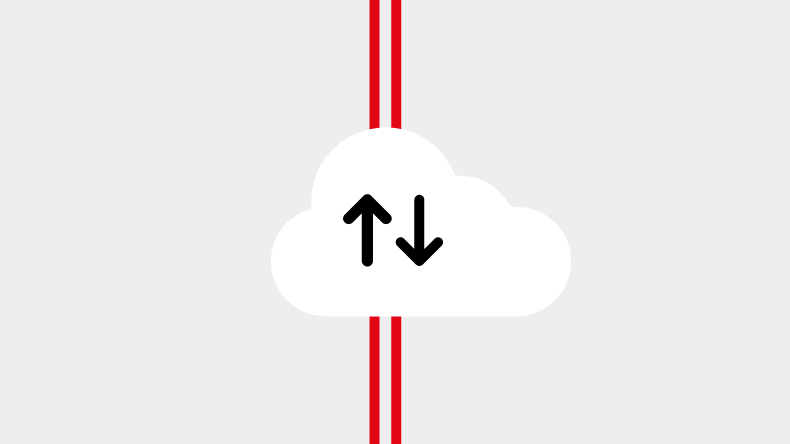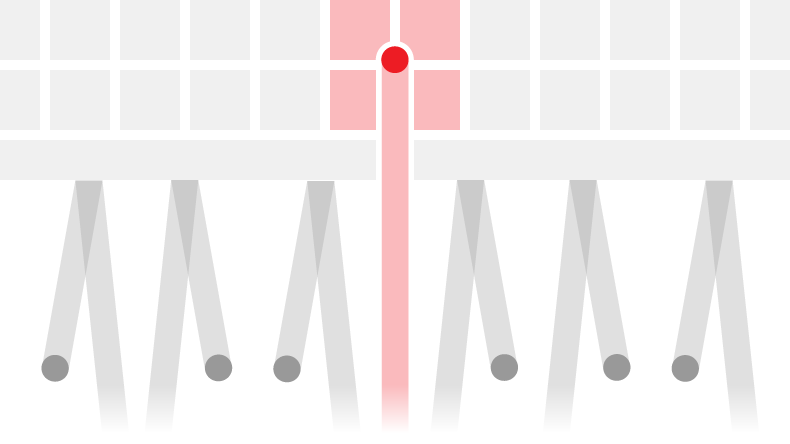Leased Lines vs FTTP

Choosing the right connectivity is one of the most important business decisions you can make in this digital age.
Increasingly, being online is crucial to everything your business does.
For a modern digital business, extended periods offline, stop/start video calls, and files that download at snail pace aren't an option anymore.
(If they ever were 😉)
Today, we're going to be comparing two connectivity variations:
- Leased lines
- FTTP (Fibre to the Premises)
So, how do you choose the right one for your business?
First, let's take a quick glance:
Leased lines vs FTTP - At a glance
| FTTP | Leased line | |
| Maximum speed | 1Gbps in some locations | 10Gbps |
| Symmetric connection? | No | Yes |
| Uncontended connection? | No | Yes |
| Uptime guarantees | Up to 2 working days | Within 4 hours |
| Connection performance | No performance guarantees, plus variable contended speeds and latency | Dedicated uncontended bandwidth and guaranteed consistent performance |
| Best suited to | Home businesses that want a fast connection but don't rely on their connection's availability or stability. | SMEs and large businesses using online digital services that need 24/7/365 reliability. |
Now, let's take a look in more detail:
Contents
What is a leased line?
A leased line is a dedicated, symmetric, and uncontended data connection used to connect your business to the Internet.
With a dedicated fibre optic cable, the speed you need is only given to you.
Basically, your connection won't be hampered by peak times throughout the day.
It can provide a high-quality connection with:
- Guaranteed upload and download speeds
- Resilience
- Uptime
Leased lines are generally used to:
- Link offices to the public internet
- Link PCs and servers in different locations
- Connect LANs (Local Area Networks), or several offices together
- Carry voice & video calls
- Enable remote connections to company VPNs
- Share IT resources
A dedicated fibre optic service is an ideal solution for businesses.
There's a lot of jargon above, so let's break it down for you:
What is bandwidth?
Bandwidth is the quantity of data that can be transmitted over a connection in a given amount of time.
Consider water flowing through a pipe:
Bandwidth would be the rate at which water (data) flows through the pipe (connection) under numerous circumstances.
The maximum bandwidth can be represented by the amount of water that can possibly flow through the pipe.
The amount of water that is currently flowing through the pipe stands for the current bandwidth.
What is a symmetric internet connection?
A symmetric, or synchronous connection allows the same upload and download speeds.
Supplying a faster and more efficient service.
It's ideal for large or small offices, where multiple people connect and transfer data simultaneously to the internet.
A symmetric connection is the alternative to asymmetric.
With asymmetric, your upload speeds will be slower than your download speeds.
This is very common for traditional internet connections.
You should consider a symmetric internet connection if you have any of the following needs:
- Multiple VPN users connecting to the business remotely
- Critical cloud-based applications
- Fast & reliable connection speeds
💡 Important Note
Leased lines are always symmetrical.
What is an uncontended internet connection?
An uncontended internet connection, or dedicated uncontended bandwidth, is a dedicated internet connection that's not shared with any other users.
This type of connection is typically used by businesses that require guaranteed reliability and up-time.
With a contended service, you might have 10 other businesses also connected through the same line.
This is known as a contention ratio of 10:1 (10 businesses on 1 line).
With uncontended, you get a contention ratio of 1:1 (1 business on 1 line).
Think about it:
You don't have to share your connection with anyone else.
Giving you significantly higher speeds during peak times and guaranteed uptime.
💡 Important Note
By definition, leased lines are uncontended connections. Not shared with any other.
Are leased lines worth it?
In our view, leased lines are worth every penny.
The biggest benefits of a fibre optic leased line is:
- Dedicated bandwidth & speed
- Consistent performance guarantees
It's ONLY negative is the cost.
However:
Due to the knock-on improvements it will bring to the rest of your business, this should always be seen as an investment.
Consider the following questions before thinking about a leased line:
- Is connectivity critical to your business?
- Do you have high data requirements?
If you answered “yes” to either of these, we would recommend you get a leased line for your business.
How fast is a leased line?
Leased line speeds can be ridiculously fast.
There are packages available that can deliver up to 10Gbps.

Honestly, it's true! 😉
Leased lines are usually defined in two parts:
- Line speed
- Bearer speed
You will usually see it like this:
50 / 100
The 50 is a line speed of 50Mbps (Megabits per second).
This is the speed for both downloads and uploads when using a fibre cable.
The 100 is the bearer speed. This means your line can reach a maximum speed of 100Mbps.
This gives you a level of flexibility and scalability for your business.
The most common bearer sizes are 100Mbps and 1Gbps.
As mentioned earlier, you can reach 10Gbps.
But this is not widely available.
💡 Top Tip
Ensure you have a higher bearer speed over the line speed, when ordering a leased line.
This will ensure that you are future-proofing your business, as it grows.
What is FTTP?
Fibre to the Premises (FTTP), also known as Fibre to the Home (FTTH), is a broadband technology that supplies a complete fibre optic connection directly to your premises.
This is in contrast to Fibre to the Cabinet (FTTC), where data travels via fibre optic cabling to the street cabinet, with the rest of the connection to the premises covered by traditional copper cabling. FTTC connections are most affordable and available in most locations across the UK.
But they are insufficient for business use.
An FTTP connection is known to be a contended, asymmetric, and on shared infrastructure.
According to ThinkBroadband, UK full fibre (FTTP/FTTH) coverage was at 36.5% in June 2022.
It's worth noting that this figure relates to population only.
Not geographical area.
The UK Government has set itself a target of delivering gigabit-broadband nationwide by 2030.
Some of the UK network infrastructure providers helping to achieve that target include:
Openreach
Wholly owned by BT plc, Openreach effectively runs the UK's digital network.
Their current FTTP network covers around 6.5 million premises in the UK.
It is still predominantly an FTTC network.
Hyperoptic
Hyperoptic specialise in FTTP (Fibre To The Premises) installations.
In 2011, they were the first to supply a 1Gb residential fibre broadband service.
They currently cover more than 57 towns and cities across the UK.
CityFibre
CityFibre is the UK's third national digital infrastructure platform, with existing networks in more than 60 towns and cities.
They supply Wholesale connectivity to multiple business and consumer service providers, local authorities, and mobile operators.
Gigaclear
Gigaclear is dedicated to bringing fibre broadband to rural communities.
They cover more than 22 counties across the South West, the Midlands and South East.
This includes 400 rural communities, with over 250,000 homes and businesses.
How fast is FTTP?
An FTTP connection can currently deliver ultrafast broadband speeds up to 910Mbps in the UK.
It isn't available everywhere yet.
Some broadband providers who can deliver that speed include:
What is the difference between FTTP and a leased line?
Both FTTP and leased lines utilise fibre optic technology.
Data travels down the individual fibres at the speed of light and unlike copper the signal strength doesn't degrade over greater distances.
But there are several key differences between FTTP lines and leased lines.
They include:
Service Level Agreements (SLAs)
Leased line connections come with an uptime guarantee.
Usually, 100% 😮
In case of a fault, leased line providers will offer Service Level Agreements (SLA), such as 4-hour break-fix, with financial backed guarantees.
They usually come with 24/7 support too.
Providers of FTTP connections usually don't offer uptime or fault guarantees.
Especially, for residential customers.
Support is usually offered within business or extended business hours.
Availability
Existing broadband infrastructure for FTTP UK coverage is at 36.5% (June 2022), which rises to 68.6% with DOCSIS 3.1 (Virgin Media).
FTTP is mostly being built using private investment.
Private companies decide when and where to build infrastructure based on commercial factors.
Commercially, where would the most users be?
Cities and towns.
If your property is based in a rural area, then you may struggle to get FTTP.
The UK Government has pledged £5 billion in funding to deliver this service to properties not reached by the commercial market (around 20% of the UK).
In reality, rural areas are going to come last when it comes to the FTTP roll-out
Waiting years for it to arrive 😭
In contrast, leased lines can be delivered almost anywhere.
Fibre Optic Cable Speeds
FTTP (Fibre To The Premises) lines are asymmetrical.
This means the download speed fibre optic cable is greater than the upload speed.
Typically, the headline download speed is 1Gbps.
Although, you will not see that connection speed through your line.
Keep in mind that FTTP providers will likely have “Fair Usage” policies in place too.
Leased lines are symmetrical.
Meaning you will have equal download and upload speeds.
They can also be used all day, every day, without limitation.
💡 Top Tip
Download speeds quoted will be the bearer speed, not the actual line speed.
The bearer speed shows the max capacity of the connection, not what you actually get 😉
Bandwidth Contention
For FTTP, connections tend to be contended.
During peak periods, your bandwidth will be shared between other users.
With a leased line, unlike FTTP, 100% of the bandwidth is dedicated to you – uncontended.
Upgrading Fibre Optic Cabling
Upgrading for both leased lines and FTTP depend on the bearer speed of the respective lines.
It is the maximum speed that can be reached on the line.
For an FTTP service, they generally max out at 1Gbps. Once you've upgraded to that amount, you won't be able to increase it further.
For a leased line, you can.
But:
It will come with a big cost.
Cost
Pricing for FTTP connections is often far cheaper and consistent than a leased line.
Installation costs are negligible, if at all.
With leased lines, the installation costs can be into the tens of thousands depending on your location.
However:
They are usually swallowed by the provider and recouped over the term of your contract.
Contract terms are typically between 36-60 months for leased line customers.
Final Thoughts
FTTP (Fibre To The Premises) is overwhelmingly used by residential addresses, rather than small businesses.
This is generally due to the way it's marketed.
It's cost effective and it can be a good choice for small business in central urban areas, where investment into the infrastructure is high.
But:
It's worth noting that due to the higher number of users in urban areas, you're more likely to get high contention.
The main areas where it falls short is the lack of dedicated bandwidth and performance guarantees via a Service Level Agreement (SLA).
Ultimately, if connectivity is critical to your business services like:
- Business telecoms/cloud telephony
- Data backups
- Video conferencing
You should seriously be considering a leased line.
In our view, it's one of the most important investments you'll make.
We really hope you enjoyed the comparison of FTTP vs leased lines.
Now we'd like to hear from you:
Do you have any further questions about this topic?
Perhaps you are considering a leased line?
Either way, let us know your thoughts.
Back to the blog.





